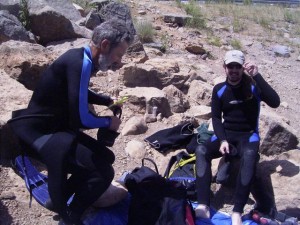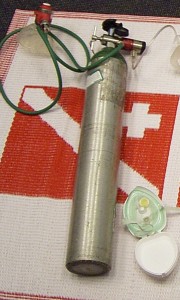Emergency Oxygen Provider
During your entry-level scuba certification, you learned about some of the risks associated with Scuba diving. You also learned that standard diving first aid often involves providing emergency oxygen to an injured diver. Emergency oxygen first aid is also highly beneficial for near drowning (immersion incident), so what you learn in the PADI Emergency Oxygen Provider course is useful there, too.
During the Emergency Oxygen provider course, you’ll review basic symptoms of decompression illness. Decompression illness is an umbrella term covering both lung over-expansion injuries and decompression sickness–gas bubbles in the blood or tissues. The reason we use the term “decompression illness” is that the first aid doesn’t change: supportive care, monitoring circulation, airway & breathing and provide emergency oxygen. Lung over-expansion injuries typically present fairly quickly after a dive. Decompression sickness, bubbles in the blood and/or tissues, usually manifests within a couple of hours. The biggest hazard of decompression sickness is that the symptoms are vague: muscle ache, fatigue, nausea, etc. After a day of diving, a bit of muscle ache from hauling gear or fatigue from being in cooler water are common. So, it’s easy to ignore the symptoms. Early first aid, including emergency oxygen, combined with early professional care can often help lead to 100% resolution in short order. Oxygen first aid, though, is not a substitute for professional medical evaluation.
Practical Emergency Oxygen Skills
Reading about oxygen or being lectured about oxygen is great, but you need some practice using the equipment. There are four required skills and one optional skill covered in this course:
- Assembly & disassembly of an oxygen system
- Non-rebreather mask for a breathing injured diver
- Demand inhalator valve for a breathing injured diver
- Pocket mask use for a non-breathing injured diver
- Manually triggered resuscitator valve for a non-breathing injured diver [Optional]
One quick note about the priority of care: If the diver is not breathing, initiate primary care–CPR. If you are alone, call for help first and then initiate care. Also, don’t interrupt primary care (CPR) to get an oxygen system. Emergency Oxygen first aid is a more advanced skill; emergency care now becomes a team sport. You need people to help you provide more advanced care. We’ll go over this during the course.
Now, I just mentioned CPR. The interesting thing is that there is no prerequisite for CPR or any other training to take the PADI Emergency Oxygen Provider course. Why? Because for most cases of decompression illness the patient is breathing and doesn’t need CPR. That said, I encourage everybody to learn CPR and First Aid. They aren’t diving specific skills, they apply everywhere. Also, since there are no prerequisites for the Emergency Oxygen Provider course, it’s open to non-divers, too. If you’re a diver and your significant other doesn’t dive, perhaps they should go through the course, too. After all, maybe you’ll be the one needing emergency care. You might also want to encourage boat captains, life guards, and anyone that is around the water to take the class. That way you have a team to help when you need them.
The PADI Emergency Oxygen Provider course complements the Rescue Diver course. I prefer to teach them together. The Emergency Oxygen Provider course substitutes for certain parts of the Rescue Diver curriculum and also counts towards your Master Scuba Diver rating.
Materials for the course
You’ll need a copy of the PADI Emergency Oxygen Provider Manual. All of the other materials for class (oxygen system, manikin, delivery masks, etc) will be provided for use during the course. If you’re diving with a buddy in remote locations, you might also want to get your own emergency oxygen system.

These divers are diving in a remote location and should probably have an extended amount of emergency oxygen.
If you’ve any questions or to sign-up for the PADI Emergency Oxygen Provider course, contact Jon.
Attention Divemasters and AI’s: you can qualify to teach this program. Contact Jon to learn more about becoming a PADI Emergency Oxygen Instructor today!
